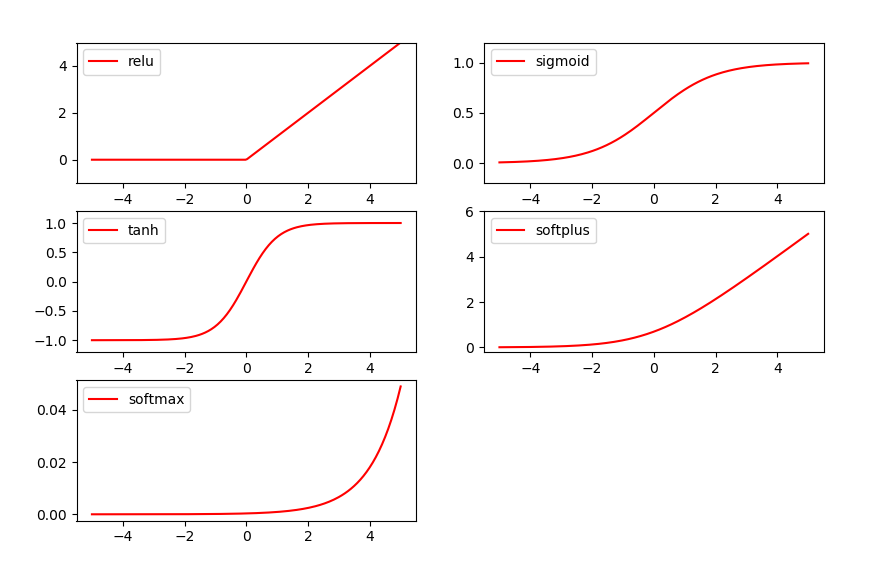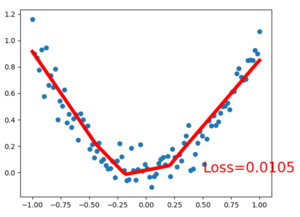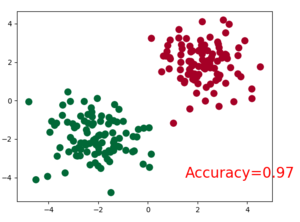Tensorflow Syntax
Session
# Method 1
sess = tf.Session()
result = sess.run(dot_operation)
sess.close()
# Method 2
with tf.Session() as sess:
result = sess.run(dot_operation)
# Run multiple ops
z1_value, z2_value = sess.run([z1, z2])
1
2
3
4
5
6
7
8
9
10
2
3
4
5
6
7
8
9
10
Placeholder
x1 = tf.placeholder(dtype=tf.float32, shape=None)
y1 = tf.placeholder(dtype=tf.float32, shape=None)
z1 = x1 + y1
x2 = tf.placeholder(dtype=tf.float32, shape=[2, 1])
y2 = tf.placeholder(dtype=tf.float32, shape=[1, 2])
z2 = tf.matmul(x2, y2)
1
2
3
4
5
6
2
3
4
5
6
Activation
x = np.linspace(-5, 5, 200) # x data, shape=(100, 1)
y_relu = tf.nn.relu(x)
y_sigmoid = tf.nn.sigmoid(x)
y_tanh = tf.nn.tanh(x)
y_softplus = tf.nn.softplus(x)
y_softmax = tf.nn.softmax(x)
y_relu, y_sigmoid, y_tanh, y_softplus, y_softmax = sess.run(
[y_relu, y_sigmoid, y_tanh, y_softplus, y_softmax])
1
2
3
4
5
6
7
8
2
3
4
5
6
7
8

Simple Regression
tf_x = tf.placeholder(tf.float32, x.shape) # input x
tf_y = tf.placeholder(tf.float32, y.shape) # input y
# one hidden fully connected layer
l1 = tf.layers.dense(tf_x, 10, tf.nn.relu) # hidden layer
output = tf.layers.dense(l1, 1) # output layer => output one float number
loss = tf.losses.mean_squared_error(tf_y, output) # compute loss
optimizer = tf.train.GradientDescentOptimizer(learning_rate=0.5)
train_op = optimizer.minimize(loss)
sess = tf.Session() # control training and others
sess.run(tf.global_variables_initializer()) # initialize var in graph
for step in range(100):
# train and net output
_, l, pred = sess.run([train_op, loss, output], {tf_x: x, tf_y: y})
# plot and show learning process
if step % 5 == 0:
plt.cla() # clear current axis (clear previous drawn line)
plt.scatter(x, y)
plt.plot(x, pred, 'r-', lw=5)
plt.text(0.5, 0, 'Loss=%.4f' % l, fontdict={'size': 20, 'color': 'red'})
plt.pause(0.1)
plt.show()
1
2
3
4
5
6
7
8
9
10
11
12
13
14
15
16
17
18
19
20
21
22
23
24
25
26
27
2
3
4
5
6
7
8
9
10
11
12
13
14
15
16
17
18
19
20
21
22
23
24
25
26
27

Simple Classification
tf_x = tf.placeholder(tf.float32, x.shape) # input x
tf_y = tf.placeholder(tf.int32, y.shape) # input y
# neural network layers
l1 = tf.layers.dense(tf_x, 10, tf.nn.relu) # hidden layer
output = tf.layers.dense(l1, 2) # output layer
# Use cross entropy to compute loss
loss = tf.losses.sparse_softmax_cross_entropy(labels=tf_y, logits=output)
optimizer = tf.train.GradientDescentOptimizer(learning_rate=0.05)
train_op = optimizer.minimize(loss)
# Use accuracy to measure performance
# return (acc, update_op), and creates 2 local variables
accuracy = tf.metrics.accuracy(
labels=tf.squeeze(tf_y), predictions=tf.argmax(output, axis=1),)[1]
# control training and others
sess = tf.Session()
init_op = tf.group(tf.global_variables_initializer(),
tf.local_variables_initializer())
sess.run(init_op)
for step in range(100):
# train and net output
_, acc, pred = sess.run([train_op, accuracy, output], {tf_x: x, tf_y: y})
# plot and show learning process
if step % 5 == 0:
plt.cla()
plt.scatter(x[:, 0], x[:, 1], c=pred.argmax(1), s=100, lw=0, cmap='RdYlGn')
plt.text(1.5, -4, 'Accuracy=%.2f' % acc, fontdict={'size': 20, 'color': 'red'})
plt.pause(0.1)
1
2
3
4
5
6
7
8
9
10
11
12
13
14
15
16
17
18
19
20
21
22
23
24
25
26
27
28
29
30
31
32
33
2
3
4
5
6
7
8
9
10
11
12
13
14
15
16
17
18
19
20
21
22
23
24
25
26
27
28
29
30
31
32
33

softmax_cross_entropy vs. sparse_softmax_cross_entropy
softmax_cross_entropy | sparse_softmax_cross_entropy | |
|---|---|---|
| Label Type | int32 / int64 | float32 / float64 |
| Label Shape | (batch_size, n_classes) | (batch_size) |
| Label Form | Any Integer | One-hot Encoding |
Save / Load Model
# SAVE
saver = tf.train.Saver()
sess = tf.Session()
# sess.run ...
# write_meta_graph is not recommended (can be very large)
saver.save(sess, './<dir>/<file_prefix>', write_meta_graph=False)
# LOAD
saver = tf.train.Saver()
saver.restore(sess, './<dir>/<file_prefix>')
# sess.run ...
sess.run('w1:0') # run specific operation
w1 = graph.get_tensor_by_name('w1:0') # get original tensor/operation
1
2
3
4
5
6
7
8
9
10
11
12
13
14
2
3
4
5
6
7
8
9
10
11
12
13
14
Tensorboard
Run tensorboard with tensorboard --logdir path/to/logdir
tf.summary.histogram('pred', output)
tf.summary.scalar('loss', loss) # add loss to scalar summary
merge_op = tf.summary.merge_all()
writer = tf.summary.FileWriter('./log', sess.graph) # write to file
for step in range(100):
# train and net output
_, result = sess.run([train_op, merge_op], {tf_x: x, tf_y: y})
writer.add_summary(result, step)
1
2
3
4
5
6
7
8
9
10
2
3
4
5
6
7
8
9
10
Dataset
tfx = tf.placeholder(npx_train.dtype, npx_train.shape)
tfy = tf.placeholder(npy_train.dtype, npy_train.shape)
dataset = tf.data.Dataset.from_tensor_slices((tfx, tfy))
dataset = dataset.shuffle(buffer_size=1000)
dataset = dataset.batch(32)
dataset = dataset.repeat(3) # repeat epochs, if not specified, default is 1 epoch
iterator = dataset.make_initializable_iterator()
bx, by = iterator.get_next() # returns get_next operation
l1 = tf.layers.dense(bx, 10, tf.nn.relu)
out = tf.layers.dense(l1, npy.shape[1])
loss = tf.losses.mean_squared_error(by, out)
train = tf.train.GradientDescentOptimizer(0.1).minimize(loss)
sess = tf.Session()
sess.run([iterator.initializer, tf.global_variables_initializer()],
feed_dict={tfx: npx_train, tfy: npy_train})
N = 200
# Iterate times: min(N, num_train / batch_size * epochs)
for step in range(N):
try:
# data is embedded into `train`
_, trainl = sess.run([train, loss])
if step % 10 == 0:
# run loss op on test set
testl = sess.run(loss, {bx: npx_test, by: npy_test})
# If N > num_train / batch_size * epochs, this exception will be raised
except tf.errors.OutOfRangeError:
print('Finished the last epoch.')
break
1
2
3
4
5
6
7
8
9
10
11
12
13
14
15
16
17
18
19
20
21
22
23
24
25
26
27
28
29
30
31
32
2
3
4
5
6
7
8
9
10
11
12
13
14
15
16
17
18
19
20
21
22
23
24
25
26
27
28
29
30
31
32